Picking the right screws for particle board can make or break your project. This guide will help you choose the perfect screws and use them correctly, whether you’re a DIY enthusiast or a professional woodworker.
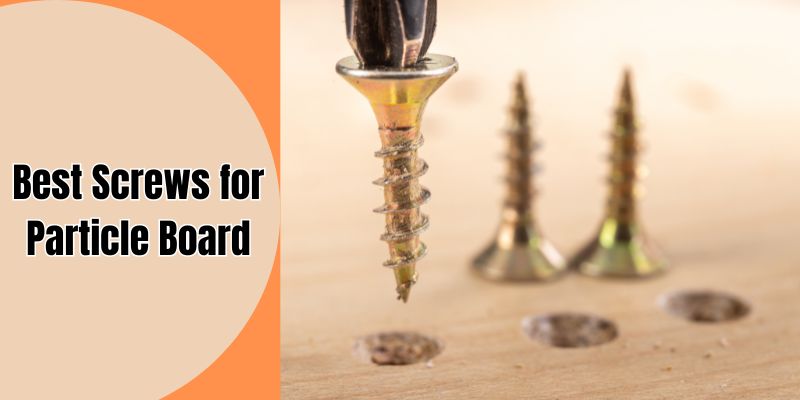
What Makes Particle Board Different?
Particle board, also known as chipboard, is made from wood chips, sawmill shavings, or sawdust held together with resin. It has a lower density than solid wood, which affects how screws behave when driven into it. Understanding these properties is key to selecting the best screws for your particle board project.
Types of Screws for Particle Board
Many types of screws available in the market but these three is Ideal.
Chipboard Screws
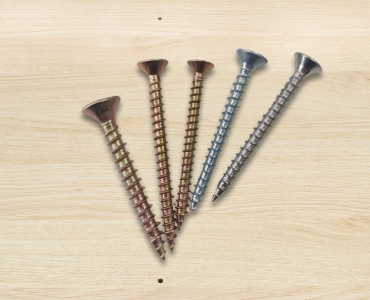
Chipboard screws are made specifically for particle board and similar materials. They have sharp, deep threads that grip the board firmly without causing damage.
Self-Tapping Deck Screws
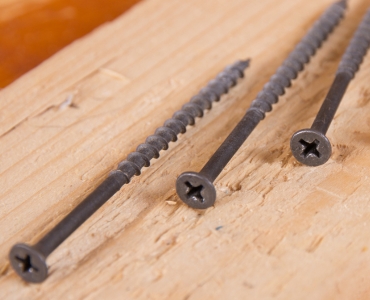
These screws can cut their own threads as they’re driven in, reducing the risk of splitting the particle board. They work well for both indoor and outdoor projects.
Read More: What are Self-Tapping Screws Used For?
Countersunk Screws
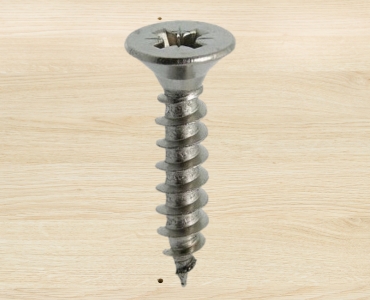
Countersunk screws have a tapered head that sits flush with the surface of the board. This creates a clean, professional look and helps prevent the screw head from catching on things.
Key Features to Look for in Particle Board Screws
Self-Tapping Ability
Self-tapping screws create their own hole as they’re driven in. This feature is helpful for particle board because it reduces the risk of splitting or damaging the material.
Screw Diameter
The diameter of the screw should be less than 20 percent of the board’s thickness. This rule helps prevent the board from splitting while still providing a strong hold.
Parallel Threads
Screws with parallel threads (as opposed to tapered threads) provide better holding power in particle board. They maintain consistent contact with the material along the entire length of the screw.
Asymmetrical Grooves
Some screws designed for particle board have asymmetrical grooves. These grooves help remove material as the screw is driven in, reducing the pressure on the board and lowering the risk of splitting.
Recessed Heads
Screws with recessed heads (like Phillips or star-drive) allow for better control when driving the screw. They also reduce the chance of the screwdriver slipping and damaging the board’s surface.
Materials and Coatings for Longer-Lasting Screws
Corrosion-Resistant Options
- Stainless Steel Screws Stainless steel screws offer excellent rust resistance and durability. They’re a good choice for projects that might be exposed to moisture or humidity.
- Carbon Steel Screws with Protective Coatings Carbon steel screws are strong and affordable. When coated with protective materials, they can resist rust and corrosion effectively.
Rust-Resistant Coatings
- Zinc Coating Zinc-coated screws, also known as galvanized screws, have a layer of zinc that protects the underlying metal from rust and corrosion.
- Black Phosphate Finish Screws with a black phosphate finish have good rust resistance and a dark color that can blend well with certain projects.
- Yellow Cadmium Finish While less common due to environmental concerns, yellow cadmium-plated screws offer excellent corrosion resistance and a distinctive appearance.
Best Practices for Using Screws in Particle Board
Creating Pilot Holes
Drilling pilot holes before inserting screws can greatly reduce the risk of splitting the particle board. The pilot hole should be slightly smaller than the screw’s shaft.
Screwing into the Face vs. the Edge
When screwing into the face (flat surface) of particle board, you generally have more flexibility with screw placement. However, when screwing into the edge, be extra careful to avoid splitting. Use thinner screws and always drill pilot holes for edge applications.
Avoid Over-Tightening
Particle board can easily be damaged by over-tightened screws. Stop turning the screw as soon as the head is flush with the surface of the board.
Particle Board Fastening Techniques
For the strongest hold, consider using wood glue in addition to screws. Apply the glue before joining pieces, then use screws to clamp the pieces together while the glue dries.
Top Screws for Different Uses
Indoor Projects
For indoor furniture or shelving, standard chipboard screws or self-tapping screws with a basic coating should suffice. The main focus here is on the screw’s ability to grip the particle board effectively.
Outdoor Projects
Outdoor applications require screws with superior rust and corrosion resistance. Stainless steel screws or those with high-quality zinc coatings are good choices for decks, outdoor furniture, or any project exposed to the elements.
Composite Wood Projects
When working with composite wood (a mix of wood fibers and plastic), use screws specifically designed for composite materials. These often have a cap-style head to prevent mushrooming of the composite material.
User-Friendly Features to Consider
Compact Size
Smaller screw heads can be less noticeable in your finished project. However, make sure the head is large enough to hold securely without pulling through the particle board.
Magnetic Tip
Some screws come with a slightly magnetic tip, which can help hold the screw on the screwdriver. This feature makes it easier to start the screw, especially in tight spaces or awkward angles.
Important Factors When Choosing Particle Board Screws
Screw Diameter
The diameter of the screw affects its holding power and the likelihood of splitting the board. Generally, a thinner screw is less likely to cause splitting, but it may not hold as strongly as a thicker screw.
Pull-Out Resistance
This refers to how well the screw resists being pulled out of the material. Screws with coarse, deep threads typically have better pull-out resistance in particle board.
Indoor vs. Outdoor Requirements
Indoor screws don’t need to be as rust-resistant as outdoor screws. However, if your indoor project might be exposed to moisture (like in a bathroom), opt for corrosion-resistant screws.
Top Product Recommendations
Best Overall: SPAX Multi-Purpose Screws
These screws offer a great balance of features for particle board. They have a self-tapping tip, parallel threads, and a zinc coating for rust resistance. The 4CUT point reduces splitting, making them suitable for a wide range of particle board projects.
Budget-Friendly Option: Hillman Fasteners Wood Screws
These basic wood screws work well for most indoor particle board projects. While they lack some advanced features, they provide good holding power at an affordable price.
Premium Choice: GRK Cabinet Screws
These high-end screws offer excellent performance in particle board. They have a self-tapping tip, asymmetrical threads for reduced splitting, and a zinc coating. The Torx drive head provides excellent grip for driving the screw.
Outdoor Option: Deck Plus Exterior Wood Screws
Designed for outdoor use, these screws have excellent corrosion resistance. They work well in particle board and can withstand exposure to the elements.
Tips for Successful Particle Board Projects
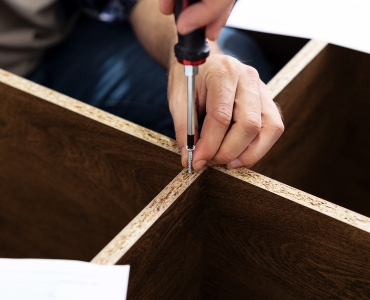
- Always drill pilot holes, especially near edges or in thinner boards.
- Use a screwdriver or drill with adjustable torque to avoid over-tightening.
- For added strength, apply wood glue before joining pieces with screws.
- When possible, drive screws into the face of the board rather than the edge.
- If you’re unsure, err on the side of using a thinner screw to reduce the risk of splitting.
- For heavy loads, consider using brackets or other reinforcing hardware in addition to screws.
- Clean your screwdriver bit regularly to ensure it grips the screw head properly.
- If a screw strips out, try using a slightly larger diameter screw in the same hole.
- For a cleaner look, countersink your screws and cover them with wood filler.
- Remember that particle board isn’t as strong as solid wood. Design your project accordingly and don’t expect it to bear heavy loads.
Frequently Asked Questions
Can I use regular wood screws in particle board?
While you can use regular wood screws, they’re not ideal. Screws designed for particle board have features that provide better holding power and reduce the risk of splitting.
Do I always need to drill pilot holes in particle board?
It’s highly recommended, especially near edges or in thinner boards. Pilot holes greatly reduce the risk of splitting and make it easier to drive screws straight.
How far should screws be from the edge of particle board?
As a general rule, keep screws at least 3/4 inch from the edge of the board to prevent splitting.
Can I use particle board screws in other materials?
Yes, particle board screws can often be used in other soft woods and engineered wood products. However, they may not perform as well in harder woods.
How do I know if I’ve over-tightened a screw in particle board?
If you see the surface of the board bulging around the screw head, or if the screw suddenly becomes very easy to turn, you’ve likely over-tightened it.
Are brass screws good for particle board?
While brass screws are attractive and resist corrosion, they’re generally too soft for particle board. The threads can strip easily, resulting in a weak connection.
Can I reuse holes in particle board?
It’s best to avoid reusing holes in particle board. If you must, use a slightly larger diameter screw to ensure a tight fit.
How do I remove a stripped screw from particle board?
Try using a rubber band between the screwdriver and the screw head for extra grip. If that doesn’t work, you may need to use a screw extractor tool.
Read Here: How to Remove a Stripped Screw: 17 Proven Methods
Is it better to nail or screw particle board?
Screws generally provide a stronger hold in particle board than nails. They’re less likely to pull out over time and allow for easier disassembly if needed.
Can I use drywall screws in particle board?
While drywall screws can work in a pinch, they’re not ideal. They’re brittle and can snap under stress. Screws designed for particle board are a better choice.
Wrapping Up
Choosing the right screws for your particle board project doesn’t have to be difficult. By understanding the unique properties of particle board and the features that make screws work well with it, you can ensure your project is built to last.
Remember these key points:
- Use screws designed for particle board when possible
- Always drill pilot holes
- Don’t over-tighten screws
- Consider the project’s location (indoor vs. outdoor) when selecting screws
- Pay attention to screw diameter and length
With these tips and the product recommendations provided, you’re well-equipped to tackle your next particle board project. Happy building!


